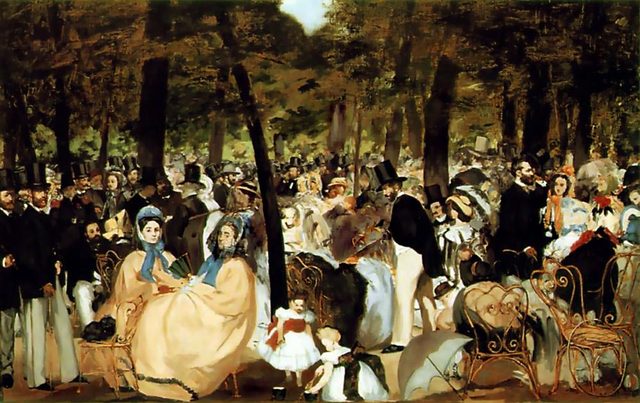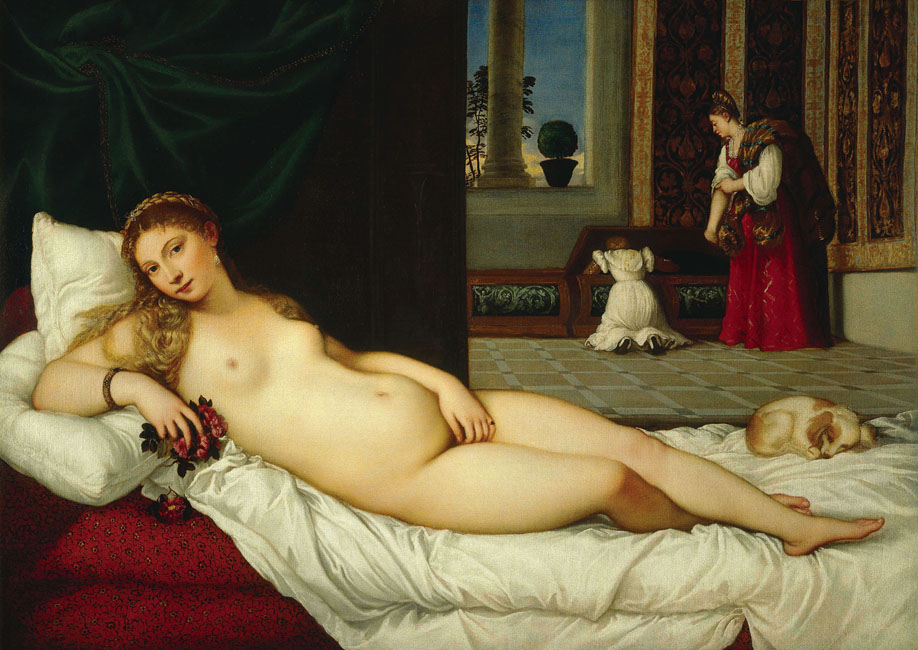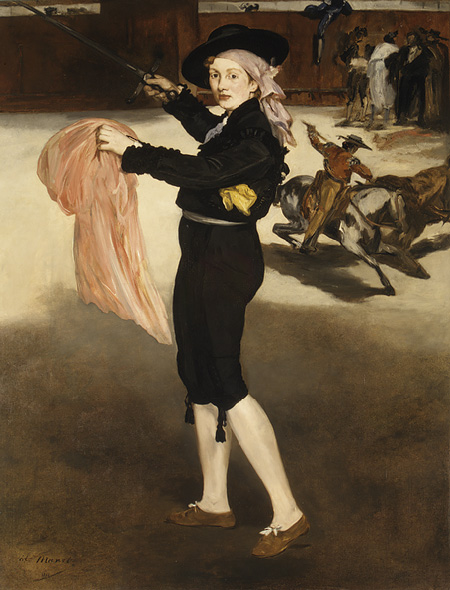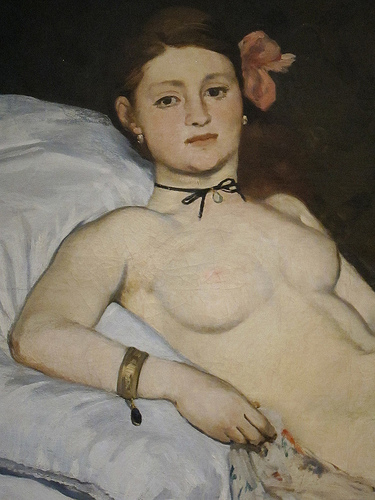“On first inspection, one might wonder what all the fuss was about. Manet considered himself a painter of still life, and perhaps that’s why Olympia has such a quiet mystery about her. She lounges serenely, starkly unclad but strategically adorned — a black ribbon around her throat, a single slipper on her left foot (the right one has dropped carelessly off), a voluptuous pink flower at her ear. Her hand is firmly clamped over her sex. The outer corners of her mouth are raised just a fraction, a moment away from a smile or a sneer. Her eyes are drowsily heavy-lidded but her posture is unmistakably alert. Compare her to any overheated, dishabille nymph of the baroque or rococo eras and she seems positively demure.”

Linda MacDonald: La Musique aux Tuileries (1862) peopled with Manet's friends and family celebrates fashionable society. His loose handling of paint and lack of subject separated this painting from the highly finished canvasses approved of by the academy, and accepted by the Salon. In addition, the painting's ambience anticipates the "snapshot" quality taken up so well by Degas, and developed further by the Impressionists.
There is no question about another painting that, in 1865, created a scandal even more painful for Manet. By the time the “Salon des Réfuses” of 1863 had closed, it left Manet bloody from the critical attacks, a little bowed, and more widely, if less favorably known than his academic antagonists. He had either completed or was completing “Olympia” , a modern version of the old test-theme of a reclining nude, with special reference in this case to a seductive portrait of a courtesan by Titian, the “Venus of Urbino” .

"...But there's something different about this female. For one thing, she's pointedly not doing anything. She ignores the bouquet that her black maid offers, and the kitten, tail at a highly suggestive full attention, that peers from the foot of her bed. She isn't bathing or dreaming or dressing. As we take her in, we realize that she's a woman naked and in bed for exactly the first reason a woman might be naked in a bed. She's there for sex, and she regards the viewer with a look that's part invitation, part dare. She's a mistress, or more likely a prostitute, but she sure as hell isn't a sprite named Springtime...."
Manet was perhaps the world’s first shock artist. Every modern provocateur who slices up a cow or assembles a Lego death camp owes him a debt of hype-making gratitude, but his influence exceeds his infamy. Well-bred, elegant and gentlemanly, Manet was as horrified by the response to “Olympia” as his critics were by the work itself.
Manet’s Parisian courtesan is a rather chunky girl of the people, arrogant not in her display of nudity but in her indifference to nakedness. Such comment as Manet makes in “Olympia” is made of an odd kind of reverse way. In fact, he makes no specific comment at all; but by presenting with vivid completeness an image that has all the noninterpretive immediacy of a snapshot, he accepted the practical realism of his time, its faith in the apparent and the tangible, its rejection of anything that could not be established by proof through common experience. On one hand this was the century’s scientific attitude, but in its popular manifestation it could take on all the tawdriness, stodginess, and self-satisfaction that eventually made “bourgeois” a derogatory word.

Titian. venus of Urbina. T.J. Clark:The achievement of Olympia, I should say, is that it gives its female subject a particular sexuality as opposed to a general one. And that particularity derives, I think, not from there being an order to the body on the bed but from there being too many, and none of them established as the dominant one. The signs of sex are present in plenty, but they fail, as it were, to add up. Sex is not something evident and all of a piece in Olympia; that a woman has a sex at all --and certainly Olympia has one-- does not make her immediately one thing, for a man to appropriate visually; her sex is a construction of some kind, or perhaps the inconsistency of several....
Manet’s incorporation of his century’s realistic philosophy into an aesthetic statement was completely misunderstood. The function of Salon art had gradually sunk to the level of a sugar coating for bourgeois vulgarity. Pseudo idealism in the rank and file of Salon painting gave flattering assurance to the inhabitants of a spiritually grubby world that they carried on the elevated principles and the refined sensibilities which, presumably, were historically typical of all great artists and their patrons.
“Olympia assured them of no such thing. It was not a comment: it was simply there. It was there with all the force, all the life, all the vitality that Manet had now learned to reveal in his paraphrases of actuality. It was there with a maddening existence of its own that rejected all compromise. There was something brash about the girl’s glance, which was infuriating; but there was something aloof, too- which was unforgivable. “olympia” this picture of a common girl, happens to be considered one of the most elegant paintings of its century; and if Manet’s critics senses this, it must have been the final and intolerable violation of their security, a reasonable explanation for their attacks upon the painting for its brutality. The only insult that Manet was spared was the accusation of effeteness. “Olympia” is not effete, but it comes closer to being effete than prurient, and prurience became the major charge against it.

---Manet was devastated. "The insults rain down on me like hail," he complained to his friend, the poet Baudelaire. Yet while many looked upon Olympia as a symbol of depravity or a slattern, others recognized her as a triumph. The writer Émile Zola called it Manet's "masterpiece," declaring, "It will endure as the characteristic expression of his talent, as the highest mark of his power ... When other artists correct nature by painting Venus they lie. Manet asked himself why he should lie. Why not tell the truth?" But the truth came at a cost.---
“Olympia” was accepted for the Salon of 1865, perhaps as a safety measure after the Emperor’s rebuke of 1863, and no doubt in the way an unwelcome guest may be invited to a party by a hostess who plans to give her a bad time. The attacks on “Olympia” were abominable. It was compared to “high” game, and the visitors crowding around it t sightseers at th
rgue- which may have been a legitimate comment on the visitors, but not on the painting.“Victorianism wasn’t strictly for the British, and no serious artist dared to paint a woman of such obvious ill repute without at least draping her in the exotic garb of harem girl. Yet here was a courtesan glorified in an homage to Titian’s “Venus of Urbino” that was so obvious spectators called it parody. But it wasn’t — Manet didn’t merely expose the prostitute to the eyes of the world, he had the audacity to worship her. It was blasphemy. How unfortunate for Manet’s detractors that it was also exquisite.”
To go into details would be repetitious; we might better look at another Manet to try to understand how a technique that seems to us as utterly brilliant , yet conventional enough, could ever have seemed so outrageous. The head of “Mlle V. in the Costume of an Espada” will do as an example.

Met:As many noted, Manet reproduced a scene from Goya's Tauromaquia as the backdrop for this painting. He depicted his favorite model, Victorine Meurent (1844–1928), as though she were being photographed in costume for a fancy-dress ball, borrowing her pose from a print by Marcantonio Raimondi after a work by Raphael. X-radiographs reveal an unfinished painting of a nude beneath the surface of the picture. Meurent was a painter herself, exhibiting work in the 1870s and 1880s and at the turn of the century. Source: Édouard Manet: Mademoiselle V. . . in the Costume of an Espada (29.100.53) | Heilbrunn Timeline of Art History | The Metropolitan Museum of Art
In conventional academic painting a form was rounded out by a system that tried to combine the natural color of an object with the full range of light and shade; from high light to deep shadow. In a small area the natural color could appear in its purity and its full intensity, but as it modeled to turn into the light it had to be bleached, and as it turned away into the shadow it had to be darkened, which usually meant muddied. In the final rendering not much of the natural coloring was left.
To approximate the intensity of the eye’s experience of color in nature, Manet rejected the conventional formula for one in which the half tones on either side of the natural color, whether on the bleached side or on the muddied side, were eliminated. He spread the natural color at full intensity into the lights and into the darks, and depended for the description of form on sudden, dramatic concentrations of shadow in grays or near-blacks that gave additional contrast to the pure color.
As a result of this system , whole areas, like most of the face of Madame V., would be virtually flat. Modulations of small details , such as the curve of a nostril, might be all but eliminated. It has been suggested that Manet was influenced by early photographs. Made on film relatively insensitive to half tones, their reduction of foem to an almost blank spread of tone with sudden, sharp accents of darks- the iris if an eye, the inside of a nostril, the quick dark under a chin or a jutting cheekbone- gives the same forceful , abbreviated definition that Manet cultivated. The wonder of a painting like “Olympia” is that we see it completely at a glance , yet that it remains inexhaustible.

Williams:To worship a goddess is easy, but to love a human -- especially one who offers no hint of reciprocation -- is far more work, and infinitely more thrilling. Manet brought the hidden world of the everyday into the light and made it remarkable. For all that's reserved about Olympia's demeanor, the passion of her creator is there in every stroke and every line. She may withhold her heart, but we, helpless, are under her spell forever.
“What upset everybody so much? It may be that she seems so unaffected herself. She stares placidly at the viewer, putting us in the uneasy role of client to an alluring, if bored-looking, whore. Manet inhabited a world in which it was generally assumed that a woman existed to nurture, comfort, inspire or arouse, all in relation to her place in society and family. But Olympia, for all her blatant accessibility, is tantalizingly self-sufficient. There’s nothing supplicating or humble about her. To the wealthy collectors of art and women, who regarded both as possessions, Olympia stripped them of their illusions. Her body is ripe for the taking, but everything else, including the meaning behind that enigmatic almost-smile, she’s keeping for herself. For all the great paintings in the history of art, few show a woman whose gaze is so startlingly direct and defiantly unaccommodating.” ( Mary Elizabeth Williams )
ADDENDUM:
Excerpt from T.J. Clark’s “Olympia’s Choice,” The Painting of Modern Life: Paris in the Art of Manet and his Followers:
” A nude…is a picture for men to look at, in which Woman is constructed as an object of somebody else’s desire. Nothing I go on to say about Olympia is meant to suggest that Manet’s painting escapes that wider determination, or even escaped it once upon a time, in the 1865 Salon. It was meant as a nude and finally taken as one; the texts I have collected should not be read as so many indices of defeat in that project, but, rather, for signs of difficulty surmounted. The critics were obliged to take a metaphorical detour, produce their own hesitations, play with the picture’s recalcitrance, before they declared it a nude of some kind –comic perhaps, or obscene, or incompletely painted. Nonetheless, the difficulties counted in 1865: the anger and the uncertainty were not simply ersatz. The anger needs explaining, therefore; even if, in the critics’ writing, it is already presented in retrospect, as a kind of fiction.
I have argued the gist of the matter already. Olympia is depicted as nude and courtisane, but also as naked and insoumise; the one identity is the form of the other, but the two are put together in such a way as to make each contingent and unfinished. The case is particularly clear when it comes to the picture’s obvious main subject: Olympia’s beauty, her sexual power, and how that relates to her body’s being female. It is sometimes said –it was already in 1865– that Olympia is not female at all, or only partly so. She is masculine or “masculinized”; she is “boyish,” agressive, or androgynous. None of these words strikes me as the right one, but they all indicate quite well why the viewer is uncertain. It is because he cannot easily make Olympia a Woman that he wants to make her a man; she has to be something less or more or otherwise aberrant. This seems to me wrongheaded: surely Olympia’s sexual identity is not in doubt; it is how it belongs to her that is the problem.





 COMMENTS
COMMENTS